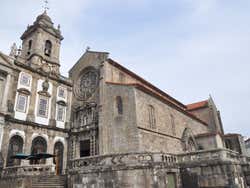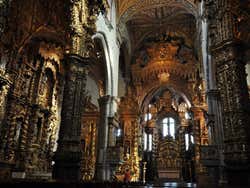
Igreja de São Francisco
The Franciscans began work on the Igreja de São Francisco in 1245, but it was later reformed due to a fire which destroyed the old cloister and part of the church.
While the church was originally built with Roman origins, it was later transformed into a Gothic style, and some years afterward, it adopted Baroque-style decor.
Inside
São Francisco has three naves coated in golden carvings. It is believed that over 300 kilos of gold dust were used to decorate the church’s interior. The temple’s ornamentation was for a time considered too extravagant for the poverty that surrounded it, so it was closed for a few years.
One of the most beautiful altarpieces of the Church is located in the North aisle. The “Tree of Jesse” is a wooden sculpture by Filipe da Silva and António Gomes depicting the family tree of Jesus, considered one of a kind.
The Catacombs
Under the Igreja de São Francisco lie the catacombs, where the Franciscan monks are buried and members of Porto’s wealthiest families. The catacombs also house an ossuary with thousands of human bones, which you can admire through a glass floor.
Our opinion
The Church of São Francisco is one of Porto’s most prominent monuments, along with the Cathedral and the Clérigos Church. You can also take the time to visit the Palácio da Bolsa, a marvellous example of nineteenth century Neoclassical architecture.


Schedule
From November to February from 9:00 a.m. to 5:30 p.m.
From March to October from 9:00 a.m. to 7:00 p.m.
From July to September from 9:00 a.m. to 8:00 p.m.
Price
Adults: € 10 (US$ 11.77)
Porto Card and students: 25% discount
Transport
Bus: lines 1, 57, 91, 23 and 49.

